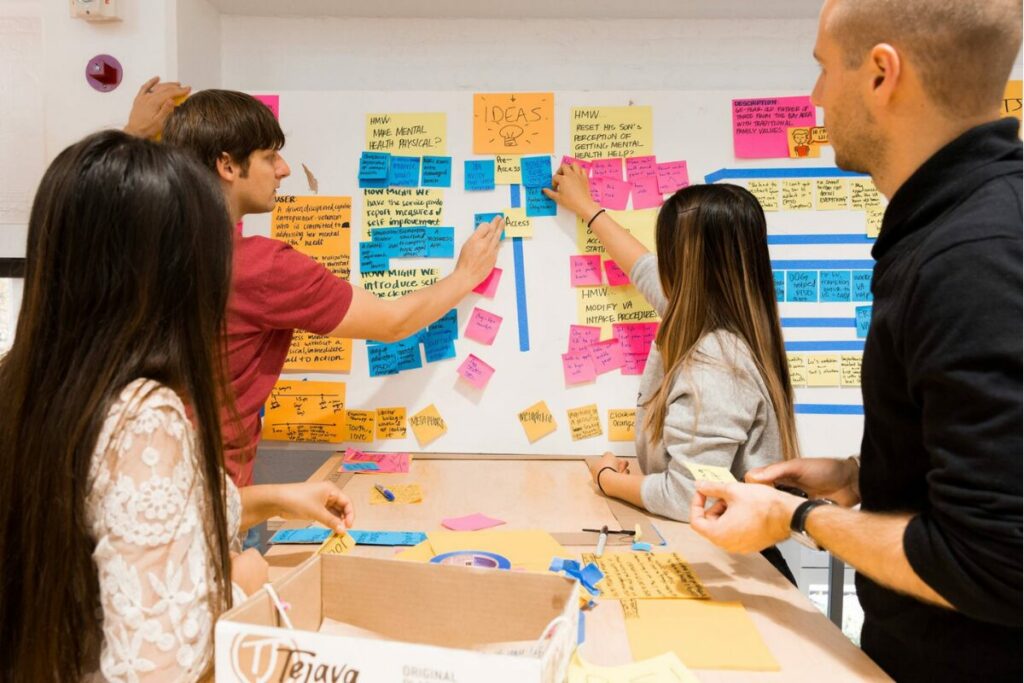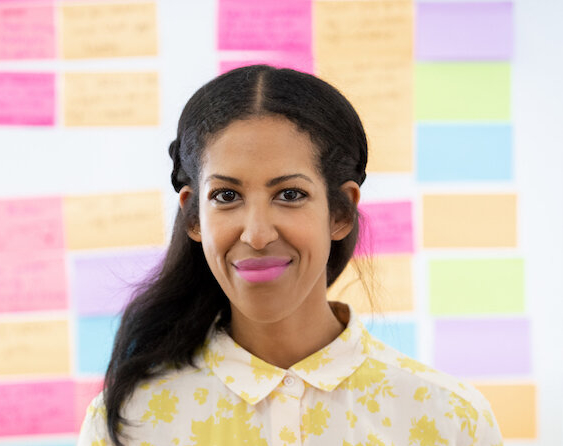There is a lot of rhetoric that emerging technology is coming, it’s inevitable, it’s flawless, and we don’t have a choice. But, that’s not true. We have a choice…We all have a right to shape how technology impacts our communities and society.
Ariam Mogos, Futurist Fellow, Stanford d.school K12 Lab
Education Reimagined recently spoke with Connie Liu, Founder and Director at Project Invent, and Ariam Mogos, Futurist Fellow in the Stanford d.school K12 Lab. Together, we explored technology, the myths of design thinking, how young people can be empowered to solve problems within their communities, and the perception shift educators must make to see and know themselves as “creatives.”
Q: What’s one of the gaps you see between education and the wider world young people are interacting with on a daily basis?
Connie: There is a lag between what the real world needs and what education is teaching. We know students need to develop their creativity, resilience, empathy, and other 21st-century skills—all of which require more than just knowing a set of facts that help them pass standardized tests.
A lot of Project Invent’s work is figuring out how we can bake those skills into the school day to help students develop these qualities that they’re going to need throughout their lives. When we look at the bigger challenges we are already aware of like climate change, global pandemics, and others that will continue challenging our world, we need students to be really strong problem solvers.
It’s often said that 80% of the jobs that exist today aren’t going to exist 10 years from now. Technology is moving too fast, and we truly don’t know what types of jobs students will need to be prepared for. But, there will always be problems that need to be solved. And, technology can help students learn to problem solve in really authentic ways that didn’t exist a generation ago.
Q: Digital technology seems to be the preferred solution for most problems across industry. Should we always be looking in that direction?
Ariam: Not at all, we are living in a world of technocentrism. There is a lot of rhetoric that emerging technology is coming, it’s inevitable, it’s flawless, and we don’t have a choice. But, that’s not true. We have a choice. This idea that “machines are going to run everything” is our own doing. These are decisions that people, corporations, and industries are making. That’s the most important thing to remember. We all have a right to shape how technology impacts our communities and society, which is the focus of our project REP at the d.school.
That said, technology can be a powerful solution in some cases. During the COVID-19 pandemic, we’ve seen how technology can connect us to our families, friends, and colleagues. It’s also helped us recognize how technology can’t replace human connection. Although it’s been incredibly sad to experience that during various lockdowns, it’s also been a fantastic reminder.
We still need to be in each other’s physical presence. I hope we never move away from that and that we never try to replace true, authentic human connection with technology.
Connie: I think the other thing that’s coming up a lot with technology is the ethics of it, which is a really good way for students to think about emerging technology. It’s not just about coding or how you can build a robot to think like a human. We have to think about the implications of it all and how we can make sure we don’t inject negative biases into what we’re creating. Those are the things we should be prompting students with at the beginning of the design process.
Q: Do you find design thinking is used in ways that are misaligned with the problem at hand?
Ariam: Design thinking is one methodology to solve problems, and it exists in many forms. It might be called something else in different fields and in different parts of the world. What the d.school has done really well is create hands-on and reflective ways of engaging with a problem that’s accessible.
I think the d.school has done it so well that people have interpreted design thinking as a silver bullet to solve any type of problem. That doesn’t mean design thinking doesn’t have a role to play, but I think it has been misinterpreted. For example, you can’t solve deeply historical, systemic challenges with design thinking. We need to look at social movements. We need to look at our laws and policies.
Connie: I completely agree. I feel like any focus on design thinking should come with a focus on systems thinking—drilling down and thinking about what solutions can solve this single problem, but also having students zoom out and consider how their solution influences the world around them.
Design thinking was introduced as six steps and then oversimplified as a rigid checklist to be followed. I believe d.school and Project Invent have both been shifting to emphasize the importance of mindset throughout the process. I think the goal of following the six steps is to build the capacity of creative confidence and empathy. That goal can be lost if things are only seen as a checklist.
Ariam: That’s exactly right. I believe the hexagons everyone is so familiar with provided an easy way to understand how to engage in problem solving. And, I could imagine if that’s the only resource I knew about when it came to solving problems, I could misinterpret it as the only way to solve problems.
Many frameworks are designed to simplify complex processes but aren’t meant to be seen as linear. I think people often think you must go through these exact six steps in this exact order, which is not how all problem solving occurs. Any problem depends on who you are and how familiar you are with the problem. Are you embedded in the context of the problem and deeply familiar with the community it’s impacting? Or are you coming in from the outside? That alone brings up different ways you must approach the problem.
Q: That’s an interesting point you brought up about context. Are you embedded within it or coming from the outside? Connie, how do you address context for a young learner who wants to tackle a problem they are interested in finding a solution for?
Connie: I think this is where building a capacity for empathy is so important. The folks who created the Liberatory Design Framework created a really great way for students to look internally at “what is my role in being the inventor or designer in this situation?” Couple that internal reflection with building community partnerships and you avoid designing in a vacuum.
Oftentimes, school- and project-based learning looks like a teacher posing a hypothetical situation and having every student design around that hypothetical. One thing that’s really important to us is making sure students are spending a significant amount of time building relationships with the people directly affected by the challenge they are addressing.
Rather than taking a shortcut and posing hypotheticals, we ask students: What do you want to design for? And, then we challenge and support them to go find a person who’s actually affected by that issue.
They are talking to real users, rather than designing from their own assumptions. We hope that is a habit they will build for every problem they solve in the future.
Ariam: I really like what Connie said. I think it’s critical for young people to start with hyper local design experiences—designing within the communities that they themselves understand versus trying to embed themselves in other contexts they’re not familiar with.
I also believe intercultural and cross community experiences are critical. I don’t believe if you’re not from a community, you don’t have a role to play. But, if you’re not addressing issues within your own community to start with and developing design abilities within a context you’re familiar with, then I would wonder why you would attempt to embed yourself in another community without that skill set.
I think local to global experiences are ideal. And, when you’re going global (or beyond your community), there can be a really fruitful exchange of knowledge and experience.
Q: How does a designer (young learner or adult) avoid seeing every potential way their proposed solution might be “wrong” and never getting started vs. being ok that their first iteration won’t be perfect?
Connie: A challenge teachers often have when guiding students through the design process is seeing a student or group of students come up with an idea that the teacher has seen before and knows won’t work. Do you tell them that right off the bat and squash that excitement or do you let them explore their way to that discovery themselves?
Students need the appropriate scaffolding that doesn’t introduce the design thinking process all at once—overwhelming them with a bunch of complex topics. We want to loop in the process and the language as things move along.
A good example is building the understanding that you as a designer are not the savior. We can teach that in the beginning but also remind students as they prepare to interview the people they are designing a solution. These are the people who are the experts of their situations. We can reiterate the idea that students are designing with and not for. The repetition and reminders help build that habit of mind and the scaffolding helps prevent students from being scared away.
Ariam: We live in a world where the thing we create might impact people who never have any intention of ever using the technology we create or aren’t aware it even exists, which is really interesting to think through as a designer. It’s not just about identifying who will use the design firsthand but to also consider how it will impact people who won’t use it but will be affected by it. In that discovery process, if you realize the implications are going to be harmful, it’s a good thing not to move forward.
We really have to unpack and address the mindset that it’s okay if you’ve designed something that isn’t a good fit for the community because it was unintentional. It still created harm. There are some things that don’t need to exist and shouldn’t exist in the world and that’s good.
That doesn’t make you any less of a designer, a maker, or a creator. It actually just makes you an ethical human being. I hope we as educators start to support young makers to adopt these values and practices.
Q: The role of building empathy in young people isn’t the first thing people think about when asked what the role of an educator is. What kind of perception shift would you like to see from educators themselves and society writ large when it comes to the role educators play in a child’s life?
Connie: So much of it is changing the framing from being a teacher to being a master learner and one who co-learns with students. It’s important to show students what it looks like to be a curious person who is trying to discover what is true about the world.
Right now, in students’ eyes, teachers are most often seen as a source of truth or a source of answers. When a student goes to a teacher and says, “I don’t know how to solve this,” we want them to ask how the teacher might approach finding the answer, rather than simply asking for the answer.
That subtle shift has been really key for Project Invent and how we train teachers and our teacher fellowship. We have them go through six practices we want them to develop, including “leaving room for exploration” and “making failure okay.”
I think the necessity to move towards classrooms where students are willing to take more risks and solve problems that don’t have answers yet is really critical for them to feel prepared to solve problems throughout their lives.
Ariam: I would like to see the perception shift from classroom instructors or behavior managers to learning designers. I want teachers to see themselves as creatives and creators. We don’t hear enough of that kind of language in the education space.
Teachers have challenging roles. They’re not always honored for the work they do. They’re not compensated well. They’re nurturing, caring for, and shaping our young people, and when we recognize that, we see they have a very critical role to play in society.
I think that shift in identity from instructor to learning designer will be really important for them to learn, create, and solve problems alongside their students.


